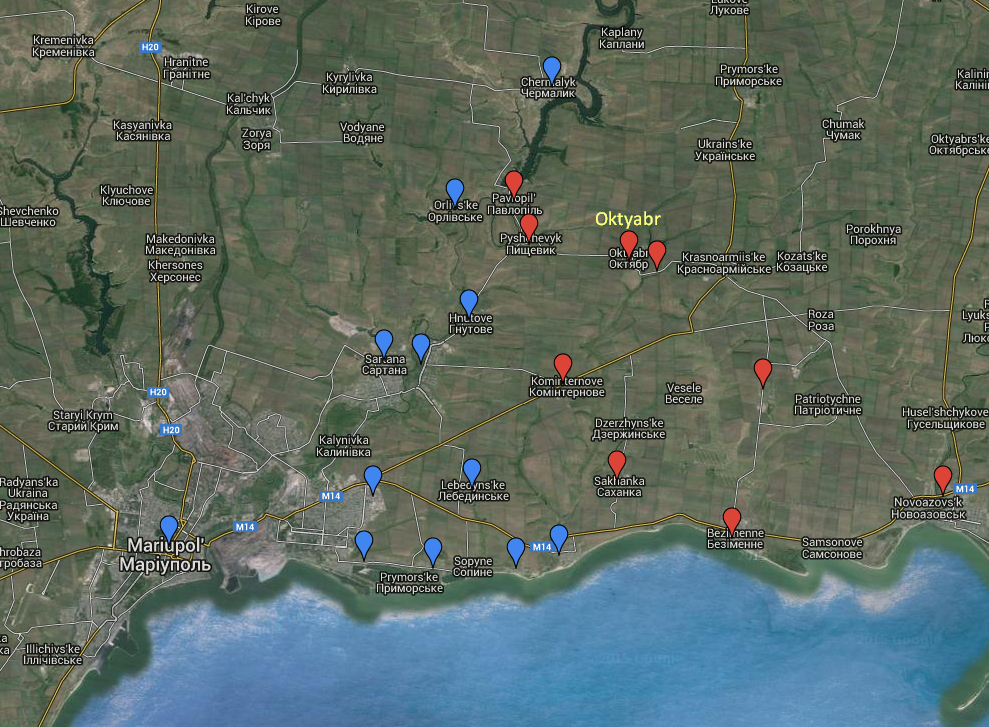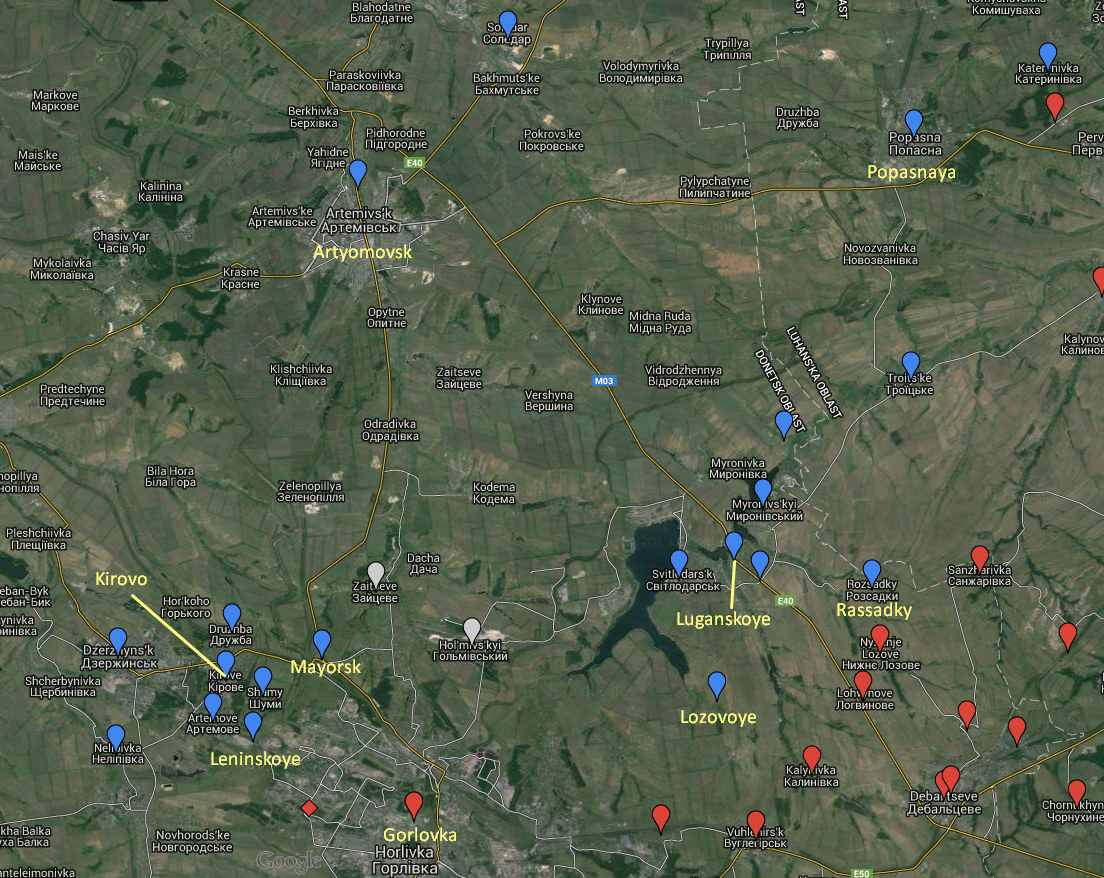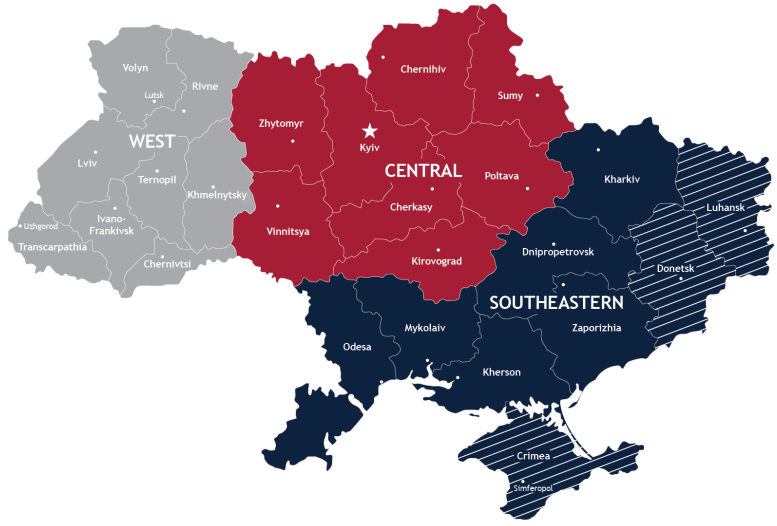Yesterday’s live coverage of the Ukraine conflict can be found here. An archive of our liveblogs can be found here. For an overview and analysis of this developing story see our latest podcast.
Please help The Interpreter to continue providing this valuable information service by making a donation towards our costs.
For links to individual updates click on the timestamps.
For the latest summary of evidence surrounding the shooting down of flight MH17 see our separate article: Evidence Review: Who Shot Down MH17?
The lights went out in much of Mariupol this evening, Novosti Donbass reported.
About 21:00, three districts of the city completely lost power, and water pumps stopped working, so residents lost water pressure.
Residents heard several explosions around that time. But while separatists fired 16 times in the last 24 hours, they were all in Shirokino, said the local press service.
But at 21:35, the power was back on.
People were in a panic, Mariupol News said because they feared this was a harbinger of the sort of shelling they had January 24, when 30 people were killed. They said that usually when there are power losses, the street lights work, but this time there was no light either in buildings or on the streets.
The housing department said there was an accident on the power lines and was working to determine the reasons for the accident.
— Catherine A. Fitzpatrick
Anatoly Vinogrodsky, a fighter from the Azov regiment, wrote on his Facebook page today that a member of the Dudayev Battalion, a unit formed of Chechens fighting on the Ukrainian side, was killed yesterday outside Stanitsa Luganskaya.
The deceased fighter went by the call sign Aktyor (actor).
The Interpreter translates:
Yesterday outside Stantisa Luganskaya we lost Aktyor. A fighter from the Dzhokhar Dudayev Battalion.
My friend, my blood brother.
Kolya… In eternal memory.


— Pierre Vaux
This is the closest to Mariupol that we have seen confirmed reports of such advanced anti-aircraft systems being deployed.

— Pierre Vaux
The Ukrainian military’s ATO Press Centre has issued its report on today’s fighting. The Press Centre claims that Russian-backed forces have continued to press their attacks on key points of the front throughout the day, using heavy artillery and tanks.
According to the report, Ukrainian positions in Vodyanoye, Peski and Avdeyevka were attacked with artillery, mortars and small arms. The military also reported repeated sniper attacks.
In the Lugansk region, the town of Schastye came under fire from 122 mm mortars. In Zolotoye, to the west, Russian-backed forces conducted sniper attacks and fired on Ukrainian positions with automatic grenade launchers and small arms.
In Shirokino, east of Mariupol, Russian-backed forces reportedly employed tanks, 82 and 122 mm mortars, automatic grenade launchers and small arms in their attacks today.
Meanwhile extensive fighting has continued around Gorlovka and Artyomovsk, part of a developing pattern of increased hostilities in this area.
According to the report, Russian-backed forces fired on Kirovo, Leninskoye, Mayorsk and Popasnaya with automatic grenade launchers, machine guns and small arms. Outside Artyomovsk, the settlements of Lozovoye and Luganskoye, were shelled with 120 mm mortars. The Press Centre also claimed that anti-tank missiles and artillery had been fired at the Ukrainian-held front line village of Rassadky.

— Pierre Vaux
“I am Russian Orthodox, I go to church, for me the only church is the Moscow Patriarchate.”
As head of state, I recognize four main confessions which should be present on this land. That is Russian Orthodoxy, Roman Catholicism, Islam and Judaism. On the other hand, I will combat sectarianism harshly. I do not want the thoughts and minds of our youth to be occupied by pseudo religion.
This should all be taken into account under a law ‘On Religion.'”
As we have reported,
last year DNR forces kidnapped and killed four Protestant church members
in Slavyansk, killed them and hid their graves, after making multiple
threats against the church. Their bodies were discovered in a mass grave
with other victims of the Russian-backed forces after the Ukrainian
army liberated Slavyansk last July.
We have to wonder what
Zakharchenko plans to do with the Buryat soldiers from Russia, who are
Buddhists and who have been central to the DNR and LNR’s campaigns, notably
in Debaltsevo, if they remain in southeastern Ukraine.
The DNR
ideology is similar but not identical to the Russian state under the
1997 law which only provides full freedoms to those faiths recognized by
the Soviet government before 1985: Russian Orthodoxy, Judaism, Islam
and Buddhism, but not Roman Catholicism.
— Catherine A. Fitzpatrick
A man has surrendered himself to police in Odessa after a brief hostage crisis.
The man, armed with a pistol, had taken two female employees hostage at a pharmacy in the Noviy Privoz shopping centre on Panteleymonovskyaya street.
The Odessa police announced that the first reports of the incident were received at 14:30 (11:30 GMT). After police arrived at the scene, the hostage-taker agreed to exchange the women for the deputy head of the regional police department, Dmitry Golovin.

An update from Dumskaya.net at 13:29 GMT reported that the hostage-taker had surrendered to the police after negotiations.
There are no reports of a political motive to the crime.
Initial reports, the local news site says, suggest that the hostage-taker had demanded money for medical treatment for his mother, who is in an Odessa hospital.
— Pierre Vaux
The International Republican Institute, which describes itself as “a nonprofit, nonpartisan organization committed to advancing freedom and democracy worldwide,” has released a new poll of Ukrainians. What it shows is that the majority of Ukrainians believe in the goals of the Euromaidan Revolution, but many are wary that the country may not reach those goals.
The poll, however, was not conducted in open combat zones in eastern Ukraine. If such a poll would be possible (it is likely not possible at the moment) it would potentially reveal important data about the prospects of reconciliation. Large parts of eastern Ukraine, however, were still part of the survey:

Here is what IRI said about the sample size:
• It was conducted in the 22 regional capitals of
Ukraine not under the control of Russian or Russian-backed forces, utilized an extensive sample size of
more than 17,000 respondents.
The fact that 57% of respondents want to move toward the European Union is a vindication of the central pillar of the Euromaidan Revolution. Also important — only 13% of respondents would like to see Ukraine enter the Customs Union of Russia, Belarus, and Kazakhstan.
Unfortunately, as this is the first-ever survey using these methods, it’s hard to compare data, but there is significant hesitancy about the direction Ukraine is going:
While that tweet is technically true, nearly a majority of those in Kiev also feel that the country is moving in the wrong direction. Also, there were only two cities in which respondents thought that corruption was a more serious problem than respondents in Kiev believed. Only one city ranked nepotism more seriously. In other words, it’s possible that those in Kiev are just as worried about Ukraine’s future but are more optimistic because they are further from the war and are, in general, more wealthy than respondents in many other areas, which is a historical trend which predates the current government. People in Kiev were substantially more negative when asked if their city was moving in the right direction.
The study is very detailed, asking questions about trust in the president and quality of the sidewalks, and everything in between. A few data points jump out at us, however.
Only in Kharkiv and Mykolaiv does the Opposition Bloc, the new iteration of ousted President Yanukovych’s Party of Regions, have more support that the party of current President Petro Poroshenko, and only by the thinnest of margins. Outside of Eastern Ukraine the Opposition Bloc has nearly zero support. Similarly, neither Right Sector nor Svoboda, Ukraine’s two ultranationalist parties, have the largest amount of support in any city, and their strongest numbers are coming out of Western Ukraine.
The entire report can be read here.
— James Miller
The Ukrainian military has accused Russian-backed forces of using incendiary munitions against residential areas of Peski, north-west of Donetsk.
The ATO Press Centre claimed today that the Russian-backed fighters were pursuing a “scorched earth” strategy in the area.
The Interpreter translates:
“There are practically no civilians left in the village – only units of the Ukrainian Armed Forces. The militants are operating on a ‘scorched earth’ principle and this time used incendiary (likely phosphorus) munitions on residential areas.”
The Press Centre published photos of one house, on Chervonoarmeiysk street, purportedly destroyed with such weapons. According to the report, the fire lasted for at least 12 hours.




The Press Centre noted that the use of phosphorus against military units in or near settlements was prohibited under Protocol III of the UN Convention on Certain Conventional Weapons.
On April 13, the Ukrainian National Security and Defence Council (NSDC) denied claims from members of the volunteer-based Krym Battalion that Russian-backed forces had used phosphorus munitions against the very same area.
One of the photos posted on the Krym Battalion Facebook page was demonstrated to be an old image. Furthermore, the NSDC claimed that the Krym Battalion was not actually deployed in Peski.
The ATO Press Centre also announced today that a residential area of Avdeyevka, north-east of Peski, had been shelled on May 18 with 152 mm artillery.
UNIAN reports in English on another statement published today by the ATO Press Centre, on last night’s shelling across the front lines.
According to the report, in the Lugansk area, the militants fired anti-aircraft guns, mortars and rocket-propelled grenades on the town of Schastye, and on the villages of Tryokhizbenka and Krymskoye. In particular, they fired mortars twice directly on the town of Schastye at night.
“In the area of the town of Avdeyevka, the militants repeatedly fired different types of weapons on the villages of Zolotoye, Kirovo, Katerinovka, Leninskoye and the towns of Popasnaya and Mayorsk,” the report says.
In the area of Donetsk, the militants fired mortars of a calibre greater than 100mm and artillery, both banned under the Minsk peace agreement, on the villages of Verkhnyotoretskoye, Peski, the Butovka mine and Novolaspa.
“The militants also fired from a tank on the villages of Opytnoye and Peski. Around midnight, they fired 120mm mortars on the village of Peski, using incendiary munitions,” the press service said.
It also reported that in the area of Mariupol, the militants, as well as on previous days, continued to fire on the village of Shirokino. They used tanks, mortars, and rocket-propelled grenades. Snipers were also at work there.
In addition to the village of Schastye, the militants fired on the villages of Granitnoye, Katerinovka and the town of Popasnaya in the last day.
— Pierre Vaux
Nils Muiznieks, Commissioner for Human Rights at the Council of Europe, has told Russia’s Kommersant that he hopes to visit separatist-controlled areas of eastern Ukraine at the end of June.
Muiznieks visited occupied Crimea in September last year. Kommersant‘s Pavel Tarasenko asked him, in an interview published today, whether he planned to return to the peninsula.
The Interpreter translates:
I’m trying to do this. The Russian authorities assisted me in my work in September and I expect that they would do this again. But they weren’t happy with my report in Moscow, they didn’t consider it to be balanced enough. I have to return and find out to what extent my analysis was accurate. But my first priority now is to go to eastern Ukraine, to territories controlled by the separatists. I hope to be able to do this at the end of June.
Muiznieks’s report, published on October 27 last year, was extremely critical of the human rights situation in Crimea since the Russian occupation. The report can be read in full here.
Muiznieks told Tarasenko that
Since the time of my visit to Crimea I have seen a deterioration of the situation in all the spheres I studied. For example, I don’t see any results of investigations into politically motivated killings and the disappearances. The pressure on members of minorities (especially on the Crimean Tatars), the media and human rights defenders continues.
Tarasenko asked the Commissioner for his estimation of the human rights situation in Ukraine. Muiznieks replied that the killings of opposition journalists and politicians were a cause of “great concern” for the Commission.
He said that the authorities must conduct effective investigations into not only these deaths, but the killings during the Maidan protests and the Odessa clashes. However Muiznieks stressed that while the Ukrainian investigative authorities “must be completely reformed,” it was difficult to carry out such reforms during a time of war.
When asked about the human rights situation in Russia, Muiznieks replied:
My worst fears have come true with regards to the legislation on foreign agents. We have counted more than 210 NGOs, which have been negatively affected by the new rules, in the form, for example, of fines and warnings. The scale of freedom of expression is worrying. Initiatives prohibiting any critical analysis of the situation with Crimea are disturbing. Furthermore, there is Lugovoi’s law, which allows the blocking of sites without a court order, as well as the bloggers’ law that demands that the most popular of them are registered as mass media. Meanwhile, they do not have the same protection afforded to the media. We continue to be concerned by the situation in the North Caucasus, especially with regards to gender equality.
— Pierre Vaux
Most of the casualties came from two clashes, near Katerinovka (Katerynivka in Ukrainian), in the Lugansk region, and Shirokino, east of Mariupol.
While there were reports yesterday evening of four or even six killed near Katerinovka, a Ukrainian defence chief today announced that three had in fact been killed.
Volodymyr Talalay, first deputy chief of defence and mobilisation planning at the General Staff, told Ukraine’s 112 television channel last night that the earlier reports were inaccurate.
However Oleksandr Poroniuk, spokesman for the General Staff, said that losses were still being calculated.
“This is a mistake. Three soldiers killed, six wounded. These are the results of combat fight with sabotage and reconnaissance groups that ambush and penetrate the territory controlled by the Ukrainian Armed Forces. These are bad factors that indicate that the opponent is violating the Minsk agreements,” Talalay said.
In turn, the speaker of the General Staff of the Ukrainian Armed Forces, Oleksandr Poroniuk, said that the battle near Katerynivka was ended, and they were counting losses. The final data will be announced on Wednesday, May 20.
“The battle is over. This area was relatively quiet. The shelling of our units was conducted from the ‘gray zone,’ as our military call it. I hope that tomorrow [military spokesman] Andriy Lysenko will say more, but there really are losses and injuries,” Poroniuk said.
A TSN report yesterday evening stated that the troops had come under mortar fire after a reconnaissance group was sent forth to investigate movement on the front line. Later on, a vehicle sent out to recover the wounded struck a landmine.
In Shirokino, there were reports of three wounded Ukrainian soldiers.
0629.com.ua reported (translated by The Interpreter):
According to the Azov regiment’s press office, “at 3:15 am the terrorists opened fire with automatic grenade launchers on Azov regiment positions in the village of Shirokino. At 3:40 they opened fire with heavy-calibre machine guns on Azov fighters’ front-line positions.
Azov fighters opened fire in response and quickly suppressed the enemy firing positions. After that, the enemy used heavy artillery – 152 mm self-propelled guns, which are prohibited according to the Minsk agreements.”
“The battle in Shirokino continued until 6:20 am [3:20 GMT]. Azov have two wounded,” said an update from the regiment’s press office.
The press officer for the Mariupol area of military operations, Dmitry Gorbunov, said that two National Guard fighters had received shell-blast trauma during shelling at 21:30 on May 18. One fighter was born in 1997 and grew up in Kharkiv, the second was born in 1992 in Krivoy Rog. They are headed to one of the hospitals in Mariupol. Doctors assess the fighters’ condition as reasonable.
This morning, at around 5 o’clock, a National Guard serviceman, born in 1959, received shrapnel wounds from an exploding shell. He was taken, with moderate wounds, to a hospital where he is receiving medical treatment.
According to Dmitry Gorbunov, four bombardments of the ATO forces’ positions were recorded over the last day.
— Pierre Vaux